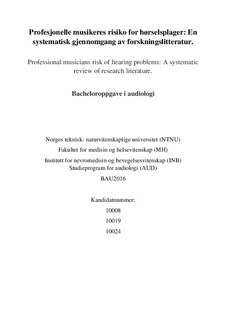| dc.contributor.advisor | Kjørstad, Kristian Haugen | |
| dc.contributor.author | Anti, Marte | |
| dc.contributor.author | Børseth, Siren Marie | |
| dc.contributor.author | Digre, Karoline | |
| dc.date.accessioned | 2019-09-06T14:03:11Z | |
| dc.date.available | 2019-09-06T14:03:11Z | |
| dc.date.issued | 2019 | |
| dc.identifier.uri | http://hdl.handle.net/11250/2613255 | |
| dc.description.abstract | Bakgrunn: Det har lenge blitt forsket på om musikere blir eksponert for mer lyd enn hva som er anbefalt i jobbsammenheng. Tidligere studier har forsket på støyeksponering, og dens påvirkning på musikeres hørsel. Til tross for dette har få forskningsartikler fokusert på om enkelte musikere er mer utsatt for hørselsproblematikk enn andre.
Formål: Målet med studien var å finne ut hvilke musikere som kan være mer utsatt for hørselsproblemer, samt å finne ut hvilke faktorer som spiller en rolle for utvikling av hørselsproblematikk i denne yrkesgruppen.
Metode: Dette studiet er en litteraturstudie, hvor 12 fagfellevurderte artikler med kvantitativ forskningsmetode ble valgt ut som primærlitteratur. Alle forskningsartiklene gjennomførte rentoneaudiometri på sine deltakere for å kartlegge deltakernes hørselsstatus.
Resultater: De samlede artiklene hadde totalt 1128 deltakere, hvor 1049 av disse var musikere. De resterende 79 var fra forskjellige kontrollgrupper. Det samlede datamaterialet viser at musikere er mer utsatt for hørselstap enn den generelle populasjonen. 25,91% av deltakerne hadde nedsatt hørsel, 34,72% av deltakerne hadde tinnitus, mens 28,23% hadde hyperakusis. Det kom frem at de mest utsatte musikerne var de som spilte messingblåsere og fløyte, samt slaginstrumenter, bass og høyfrekvente strykere. Et fåtall av musikerne brukte hørselvern, flertallet valgte vekk dette til fordel for å høre musikken. Musikerne ble utsatt for lydnivåer opp mot 110 dBA, hvilket kan skade hørselen betraktelig, om dette lydnivået holdes jevnt over en angitt periode.
Konklusjon: Musikere er en utsatt yrkesgruppe når det kommer til hørselsproblemer. Noen musikere er mer utsatt for disse plagene enn andre. Musikere velger i dag bort hørselvern, hvilket kan øke prevalensen av hørselsproblemer. Det bør iverksettes informasjonsmøter/kurs for musikere og arbeidsgivere, slik at man kan unngå en negativ utvikling i fremtiden. | |
| dc.description.abstract | Background: For many years it has been researched if professional musicians are being exposed to more sound than what is recommended in a work setting. Earlier studies have focused on noise exposure, and its impact on the musicians hearing. Despite this, few studies have focused on gathering evidence on which musicians that can be more at risk of hearing problems.
Purpose: The aim of the study was to find out which musicians could be more exposed to hearing problems, and to find out which factors may play a role in the development of hearing problems in this profession.
Method: This study is a literature study, where 12 peer reviewed articles were chosen as the primary literature. All of these articles used a quantitative survey method. All 12 research articles conducted pure tone audiometry to map out the participants’ hearing status.
Results: The collected articles had a total of 1128 participants, 1049 of these were musicians. The last 79 participants were from several control groups. The collected data shows that musicians are more exposed to hearing loss than the general population. 25,91% of the participants had reduced hearing, 34,72% of the participants had tinnitus, and 28,23% had hyperacusis. The results show that the most exposed musicians were the musicians playing brasses, flute, percussion, bass guitar and high frequency strings. A small amount of the musicians used hearing protection, but the majority chose to not use them, so that they could hear the music more clearly. The musicians were exposed for sound levels up to 110 dBA, which can result in reduced hearing if such sound levels are kept steady over an extended period.
The conclusion: Musicians are exposed in their profession when it comes to hearing problems. Some musicians are more exposed to these problems than others. Today, musicians often choose not to wear hearing protection, which can result in increased hearing problems. It should be implemented information sessions/courses for musicians and their employers, to avoid a negative development in the future. | |
| dc.language | nob | |
| dc.publisher | NTNU | |
| dc.title | Profesjonelle musikeres risiko for hørselsplager: En systematisk gjennomgang av forskningslitteratur. | |
| dc.type | Bachelor thesis | |
